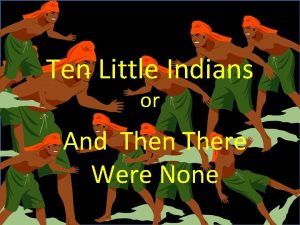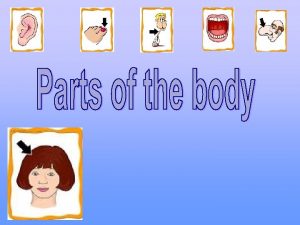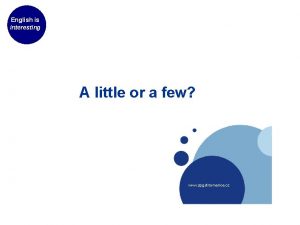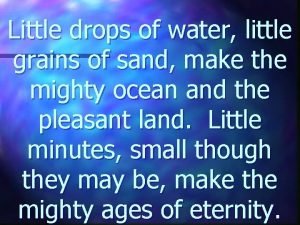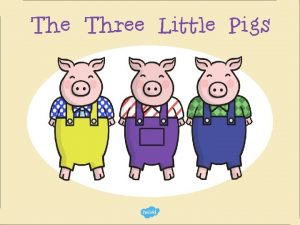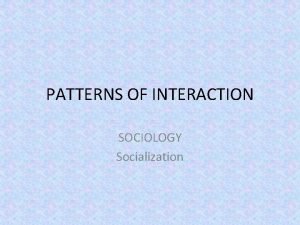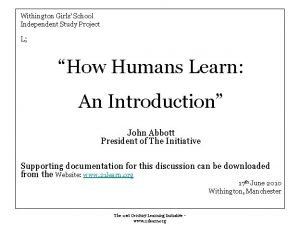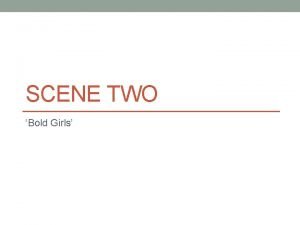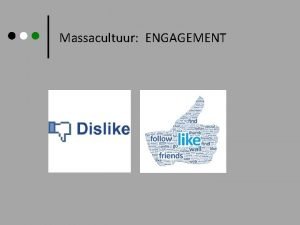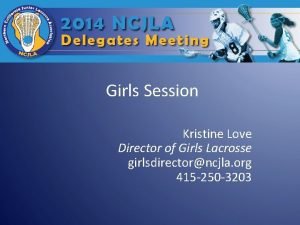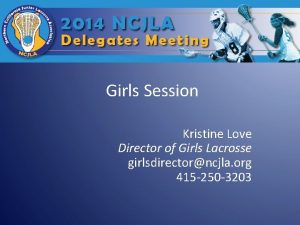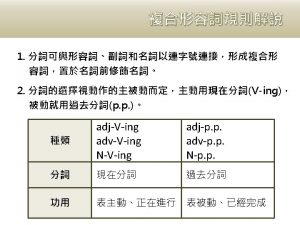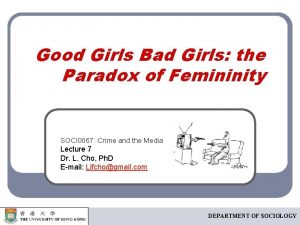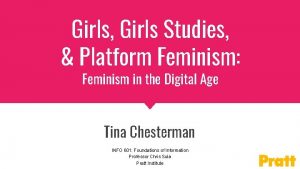What are little girls made of made of




























- Slides: 28

What are little girls made of, made of? What are little girls Morality in Kohlberg made of? Sugar and spice, and Gilligan everything nice, That’s what ittle girls are made of. What are little boys made of, made of? What are little boys made of? Snips and Snails, and puppy Debra Naukam Cassie Fredendall

What is Morality? According to Kohlberg According to Gilligan

Lawrence Kohlberg ♂ b. Bronxville, NY 1927 ♂ d. Boston, Mass. 1987 ♂ In 1958 he first published his stage theory of moral development in his doctoral dissertation at the Univerisity of Chicago. ♂ He stayed at the University of Chicago until 1968, when he went to Harvard to teach and continue his research until his death. from http: //en. wickipedia. org

Theory of Moral Development ♂Level 1: Preconventional: ♂ Stage 1: Punishment and Reward ♂ Stage 2: Hedonism/ Reciprocity ♂Level 2: Conventional: ♂ Stage 3: Good Boy/Bad Girl ♂ Stage 4: Rules of society ♂Level 3: Postconventional: ♂ Stage 5: Individual Rights ♂ Stage 6: Universal Principles

Preconventional: Stage 1 Morality is based on punishments and rewards. Judgments are formed according to external authorities. Chris, age 6: “[Heinz] did something wrong; he will go to jail. ”

Preconventional: Stage 2 Morality is reciprocal. We seek what is in our best interest, and only help others if it benefits us. Jonathan, 7 : “He shouldn’t get in trouble for stealing it because he really needed it and the man who was selling it was so greedy and only wanted the money. ”

Conventional: Stage 3 Morality is defined in terms of good interpersonal relationships. Andrea, 9: “Because if you do you are caring about other people instead of just you. ”

Conventional: Stage 4 Morality is concerned with the well-being of all and maintaining the social order. Grace, 11: “That man joined the Army and the captain has every right to order his men. ”

Postconventional: Stage 5 Morality looks at individual and moral rights within the social contract. Taya, 10: “He’s doing it for the right reasons but he shouldn’t still. ”

Postconventional: Stage 6 Morality is defined by universal principles of justice. We come to moral decisions by taking on the perspective of those involved. Christa, 14: “We must recognize all humans as human. Human life is human life. ”

Carol Gilligan ♀ Student of Kohlberg’s ♀ Later criticized his theory of moral development as being biased toward a male perspective ♀ Proposed care-orientation as an alternative method of moral reasoning ♀ Believes girls are more inclined towards care-orientation so they score lower on Kohlberg’s stages because care-orientation is associated with stage 3 (good interpersonal relationships). from http: //www. albany. edu

Gilligan’s Three-Stage Theory ♀Preconventional: Egocentricism ♀Conventional: Care for others ♀Postconventional: Balancing care for self and others “The moral judgments of women differ from that of men in the greater extent to which women’s judgments are tied to feelings of empathy and compassion and are concerned

The Question Will girls be classified at a lower stage of moral development, as compared to the boys of the same age that Kohlberg studied?

The Study Kohlberg’s original research study included 72 middle- and upperclass males, ages 10, 13, and 16 from the Chicago area, with an added comparison group of 12 delinquent boys. Kohlberg tested their moral development using 8 dilemmas with questions, and he published the results in his 1958 dissertation. We attempted to replicate Kohlberg’s original study using only two of the hypothetical dilemmas on an all-female subject base. Then we compared our results with Kohlberg’s.

Hypothesis Based on reading Carol Gilligan’s critique of Kohlberg’s theory, we hypothesize that the girls we test will be in a lower stage of moral development than the boys Kohlberg originally tested. Also, we hypothesize that as age increases, the observed difference in moral decision making between girls and boys will increase.

The Heinz Dilemma In Europe, a woman was near death from a special kind of cancer. There was one drug that the doctors thought might save her. It was a form of radium that a druggist in the same town had recently discovered. The drug was expensive to make, but the druggist was charging ten times what the drug cost him to make. He paid $400 for the radium and charged $4, 000 for a small dose of the drug. The sick woman’s husband, Heinz, went to everyone he knew to borrow the money and tried every legal means, but he could only get together about $2, 000 which is half of what it cost. He told the druggist that his wife was dying and asked him to sell it cheaper or let him pay later. But the druggist said: “No, I discovered the drug and I’m going to make money from it. ” So having tried every legal means, Heinz gets desperate and considers breaking into the man’s store to steal the drug for his wife.

Heinz Questions ♂ Should Heinz steal the drug? ♂ Is it actually right or wrong for Heinz to steal the drug? Why? ♂ Is Heinz violating the druggist’s rights? Why? ♂ If Heinz was caught, what sentence should the judge give him? ♂ It is against the law for Heinz to steal. Does that make it morally wrong? Why? ♂ Which is more important: saving another person’s life or obeying the law? Why? ♂ Does it matter if the other person is a stranger? Why?

The Bridge Dilemma In Korea, a company of Marines way outnumbered and was retreating before the enemy. The company had crossed a bridge over a river, but the enemy were mostly still on the other side. If someone went back to the bridge and blew it up, with the head start the rest of the men in the company would have, they would probably then escape. But the man who stayed back to blow up the bridge would not be able to escape alive. The captain himself is the man who knows best how to lead the retreat. He asks for volunteers, but no one will volunteer. If he goes himself, the men will probably not get back safely and he is the only one who knows how to lead the retreat.

Bridge Questions ♂ Should the captain order a man to go back on the mission, or should he go himself? Why? ♂ Should the captain send a man when it means sending him to his death? Why? ♂ Should the captain go himself when it means the men will probably not make it back safely? Why? ♂ Does the captain have the right to order a man if he thinks it’s best? Why? ♂ Does the man who is selected have a duty or obligation to go? Why? ♂ What is so important about human life that makes it so important to save or protect? Why?

Kohlberg’s Coding Forms Heinz Dilemma Bridge Dilemma

Guiding Terms for Stage Assessment: ♂ Value: Modes of attributing moral value to acts and persons. Differentiating and relating means and ends, intentions and consequences, one person’s evaluation and others, etc. Modes of assessing valueconsequences in the situation. ♂ Choice: The kind of identification with the actor in conflict and methods of resolving the conflict. The social process of moral argumentation and the capacity for making and maintaining an independent choice. The outcome chosen in a particular situation. ♂ Rule: The type of concept against which an act is assessed, on which guides conformity, e. g. taboo, rule, law. The concept of duty or moral compulsion. ♂ Role: Modes of defining concepts of good person and good role. ♂ Authority: The kind of respect accorded to authority and status and the reasons for which such respect is accorded. ♂ Justice: Concern for and concepts of rights and the legitimate relation of one act, as deserved, to another. Standards of exchange, reciprocity, contract, punishment and reward.

Our Data Heinz Dilemma Bridge Dilemma Name Age Value Choice Rule Role Justice Value Choice Rule Role Authority Justice Final Stage Grace 11 4 5 4 3 5 1 4 Jessica 10 1 1 1 4 1 2 1 5 3 1 1 Jessica 11 1 1 1 1 CJ 10 1 1 3 3 2 3 3 1 3 Taya 10 5 4 4 3 3 1 4 Christa 14 5 3 5 5 4 4 2 4 3 1 5 Guadalupe 8 1 2 1 1 1 Kimberly 9 1 2 1 1 Andrea 9 1 3 1 3 3 3 1 3 Gabriela 8 1 1 1 1

Our Results ♀ Gabriela, 8: ♀ Guadalupe, 8: ♀ Kimberly, 9: ♀ Andrea, 9: ♀ CJ, 10: ♀ Jessica, 10: ♀ Taya, 10: ♀ Grace, 11: ♀ Jessica, 11: ♀ Christa, 14: Stage 1 Stage 3 Stage 1 Stage 4 Stage 1 Stage 5

Kohlberg’s Results

Comparison Kohlberg's Sample Boys Our Girls Subject Age Stage Age Subject 1 8 Gabriela 1 8 Guadalupe #9 9 1 1 9 Kimberly 3 9 Andrea #19 10 2 3 10 CJ #15 10 3 1 10 Jessica 4 10 Taya 4 11 Grace 1 11 Jessica #25 13 3 #29 13 4 4 14 Christa #54 15 4 #77* 16 1 #66 16 4 #65 16 6 #76* 16 1 * deliquents

Conclusion Although we did not have enough subjects to make a legitimate claim about gender differences in morality, we found that our eight and nine year olds were comparable to Kohlberg’s nine year old, our ten and eleven year olds were comparable to his ten year olds, and our fourteen year old was comparable to his thirteen year olds. We were not able to truly test our hypothesis because our study did not include a wide enough range of girls to assess real age-gender stage differences in morality.

Limitations of Our Study ♀ Some girls had limited comprehension of the content of the dilemmas. ♀ We scored according to Kohlberg’s original coding form, which has since been modified. ♀ 6 of 10 surveys were completed online. ♀ Not enough participants in the older age groups. ♀ On the coding form the description of Justice in the Bridge Dilemma only talks about drawing straws. None of our girls identified this as a solution. ♀ We only used two dilemmas; Kohlberg used eight.

Quotables ♀ “He should be sintenced to theft. ” ♀ “A lot of the time you just have to know that you are the only one. ” ♀ “Look what you have done to your life. ” ♀ “You can get kidnapped by the estranger that is trying to give you the drug. ” ♀ “Drugs can mess up your boby… like on one of the videos we watch with the drug monster. ” ♀ “Why kill them when you are the one how once to blow up the bridge. ” ♀ “No pecas eriwon may bid. ”
 Mikael ferm
Mikael ferm 1 little 2 little 3 little indian
1 little 2 little 3 little indian 1 little 2 little 3 little indians
1 little 2 little 3 little indians Few, a few, little, a little exercise
Few, a few, little, a little exercise A few ja few ero
A few ja few ero Complete with these words
Complete with these words Two little hands two little feet poem
Two little hands two little feet poem Little mouse contract address
Little mouse contract address Quantifier of fresh air
Quantifier of fresh air Use of few a few the few
Use of few a few the few Little drops of water
Little drops of water Once upon a time there were three little pigs
Once upon a time there were three little pigs Mean girls sociology
Mean girls sociology Hello boys and girls
Hello boys and girls Boys and girls brains
Boys and girls brains Uvita suicide
Uvita suicide Jacksonville high school girls basketball
Jacksonville high school girls basketball Withington girls school
Withington girls school The laughter of stafford girls' high poem
The laughter of stafford girls' high poem Bold girls summary
Bold girls summary Adhd symptoms in women
Adhd symptoms in women Good morning, boys
Good morning, boys Prolactin
Prolactin Cady's map to north shore high school
Cady's map to north shore high school Precocious puberty treatment
Precocious puberty treatment Reno nevada sexy girls
Reno nevada sexy girls Task 1 new shoes
Task 1 new shoes Ashira girls secondary school
Ashira girls secondary school Lucy lou and my girl drew
Lucy lou and my girl drew


